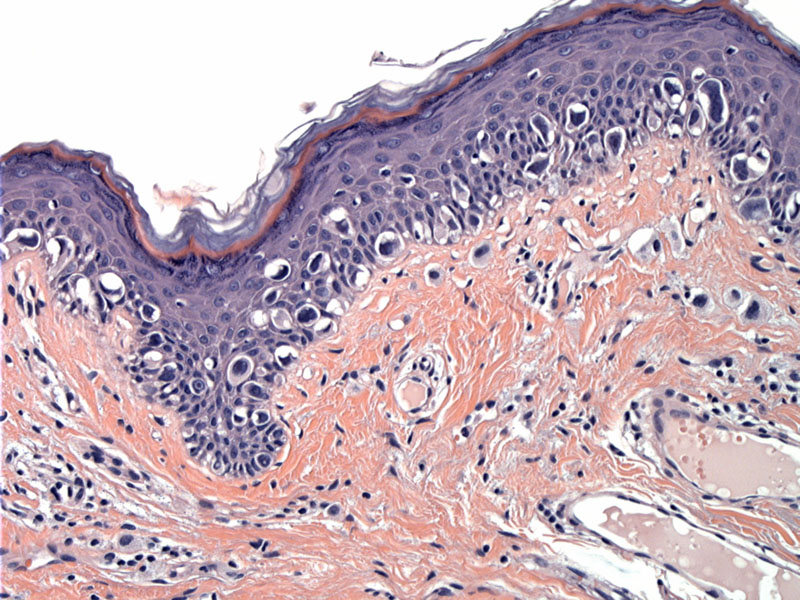

Numerous single malignant melanocytic cells in the epidermis, migrating upwards, and a few are present in the superficial dermis. At first, this variant of melanoma grows horizontally on the skin surface (radial growth phase) as seen here.
The intraepidermal component shows epithelioid cells with abundant cytoplasm that is eosinophilic, amphophilic, or has a dusty distribution of fine cytoplasmic melanin granules. The nuclei are often large and have one or more prominent nucleoli.
Pagetoid spread along the epidermis is typical; note the malignant melanocytes in the dermis.
An unknown proportion of superficial spreading melanoma cases eventuate in the downward phase of growth, resulting in nodular melanoma.
The four most common variants of melanoma are the superficial spreading type, lentigo maligna type, nodular type and acral type.
The superficial type is said to be the most common type, but a recent (2009 Forman et al) study of 771 melanomas found lentigo maligna to be the most common subtype (56%), followed by superfical spreading (29%), nodular (4%) and acral (3%). The remaining 9% were special types. The authors suggest that there may be regional differences in subtype prevalence due to differences in risk factors (e.g. sun exposure).
The superficial spreading type is defined by pagetoid spread of melanocytes and the presence of well-formed junctional nests. The intraepidermal melanocytes are epithelioid with so-called "dusty" cytoplasm. These tend to arise de novo or in association with a nevus, and are most common on non-sunexposed skin (e.g. trunk) and linked to intermittent sun-exposure.
In contrast, the lentigo maligna type is associated with chronic sun damage, tends to favor the head, neck and arms and arises de novo (rarely associated with a nevus). Histologically, this type is characterized by single units of atypical melanocytes at the dermal-epidermal junction. Nests and pagetoid spread are less common, but can be present. There is often solar elastosis and extension along the adnexa (Forman, Busam).
Briefly, the acral type has similar histologic features as the lentiginous type, but the site is limited to palms and soles, and predominantly affects dark-skinned individuals. The nodular subtype exhibits little radial growth, and is usually a dermal proliferation of melanocytes with no in situ component.
Clinically these tumors show a haphazard (variegated) combination of color, and the lesion outline is usually sharply marginated with one or more irregular peninsula-like protrusions. The surface may show a papule or a nodule that extends for several millimeters above the skin surface.
The superficial spreading and lentigo maligna types have favorable prognosis, with 5 year survival >95%. In contrast, the 5 year survival of the acral and nodular types are 81% and 69% respectively (Pollack).
• Melanocytic : Melanoma, Nodular Type
Busam KJ. Dermatopathology: Foundations in Diagnostic Pathology 1st Ed. Philadelphia, PA: Elsevier; 2010: 465-482.
Forman SB, et al. Is superficial spreading melanoma still the most common form of malignant melanoma? J Am Acad Dermatol. 2008 Jun;58(6):1013-20.
Pollack LA, et al. Melanoma survival in the United States, 1992 to 2005. J Am Acad Dermatol. 2011 Nov;65(5 Suppl 1):S78-86.
Rapini RP. Practical Dermatopathology. Philadelphia, PA: Elsevier; 2005: 273-9.